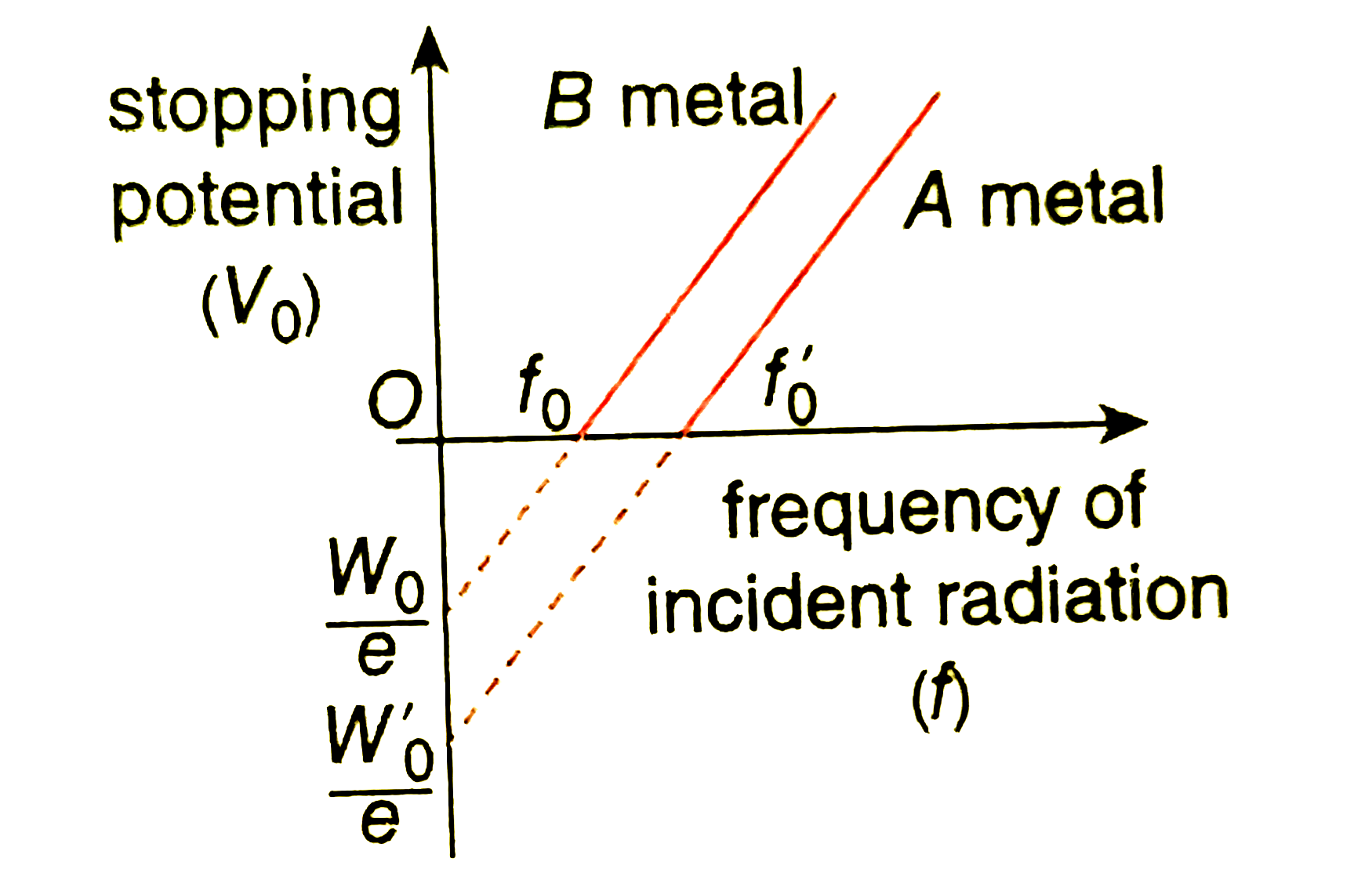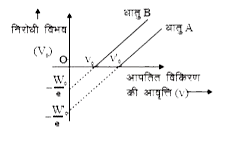The graph shows the variation of stopping potential with frequency of incident radiation for two photosensitive metal A and B. Which one of the two has higher value of work function? Justify your answer.

For metal A, W'0=hf'0, For metal B, W0=hf0
As f'0>f0 ∴W'0>W0
So, work function for metal A is greater than that of metal B
Topper's Solved these Questions
- QUANTUM THEORYBOOK - CHHAYA PUBLICATIONCHAPTER - QUANTUM THEORYEXERCISE - Examination Archive with solutions
39 Videos
- OPTICAL INSTRUMENTSBOOK - CHHAYA PUBLICATIONCHAPTER - OPTICAL INSTRUMENTSEXERCISE - CBSE SCANNER
8 Videos
- QUESTION PAPER OF NEET 2017BOOK - CHHAYA PUBLICATIONCHAPTER - QUESTION PAPER OF NEET 2017EXERCISE - QUESTION PAPERS OF (NEET) (2017)
39 Videos
Similar Questions
What will be the kinetic energy of emitted photoelectrons if light of threshold frequency falls on a metal?
View SolutionDefine the magnifying power of a compound microscope when the final image is formed at infinity . Why must both the objective and the eyepiece of a compound microscope has short focal lengths ? Explain.
View SolutionA molecule of a substance has permanent dipole moment p. A mole of this substance is polarised by applying a strong electrostatic field E. The direction of the field is suddenly changed by an angle of 60∘. If N is the Avogadro's number the amount of work done by the field is
View SolutionThe stopping potential as a function of the frequency of the incident radiation is plotted for two different photoelectric surfaces A and B . The graphs show that work function of A is

View SolutionDraw a plot showing the variation of photoelectric current with collector plate potential for two different frequencies, v1>v2 of incident radiation having the same intensity. In which case will the stopping potential be higher? Justify your answer.
View SolutionDraw a plot showing the variation of photoelectric current with collector plate potential for two different frequenciesv1andv2(v1>v2) of incident radiation having the same intensity. In which case will the stopping potential be higher? Justify your answer.
View SolutionThe graph shows variation of stopping potential V_(0) versus frequency of incident radiation v for two photosensitive metals A and B . Which of two metals has higher threshold frequency and why?
View SolutionThe figure shows the variation of stopping potential VQ with the frequency v of the incident radiations for two photosensitive metals P and
Which metal has smaller threshold wavelength ? Justify your answer.
View SolutionThe stopping potential as a function of frequency of incident radiation is plotted for two different photoelectric surfaces A and B . The graphs as shown in figure shows that , the work function of A is
View Solutionदो प्रकाश संवेदी धातुओं A और B के लिए आपतित विकिरण की आवृत्ति के साथ निरोधी विभव को प्रदर्शित किया गया है। दोनों में से किस धातु का कार्यफलन अधिक है? अपने उत्तर का औचित्य बताइए।

View SolutionThe graph shows the variation of stopping potential with frequency of incident radiation for two photosensitive metals A and B.Which one of the two has higher value of work function ?Justify your answer.
View SolutionDraw a plot showing the variation of photoelectric current with collector plate potential for two different frequencies, v1>v2 of incident radiation having the same intensity. In which case will the stopping potential be higher? Justify your answer.
View SolutionThe graph shows variation of stopping potential V_(0) versus frequency of incident radiation v for two photosensitive metals A and B . Which of two metals has higher threshold frequency and why?
View SolutionThe stopping potential as a function of the frequency of the incident radiation is plotted for two different photoelectric surfaces A and B . The graphs show that work function of A is

View Solutionग्राफ में दो प्रकाश-सुग्राही धातुओं A और B के लिए, आपतित विकिरण की आवृत्ति के साथ निरोधी विभव का विचरण दर्शाया गया है। इन दोनों धातुओं में से किसके कार्य-फलन का मान अधिक है ? अपने उत्तर की पुष्टि कीजिए।

View SolutionFollowing graphs show the variation of stopping potential corresponding to the frequency of incident radiation (F) for a given metal. The correct variation is shown in graph (V_0=" Threshold frequency")
View Solution

